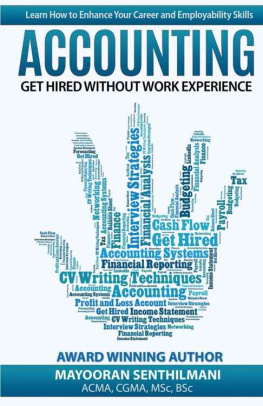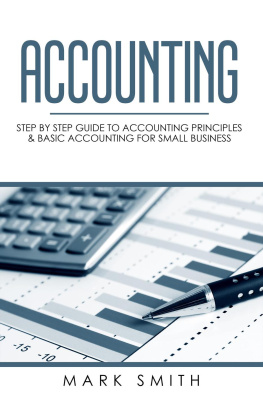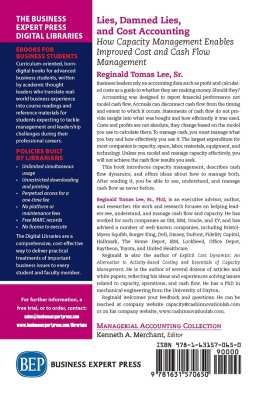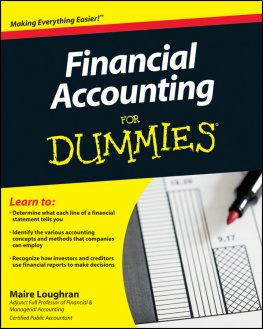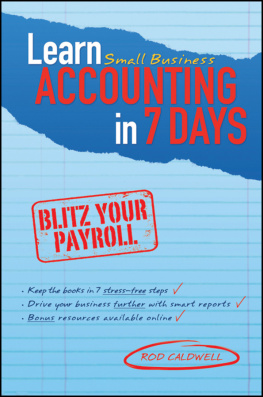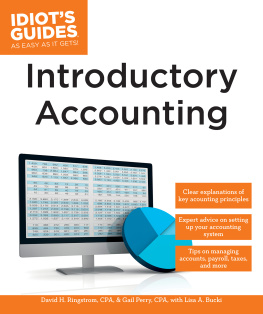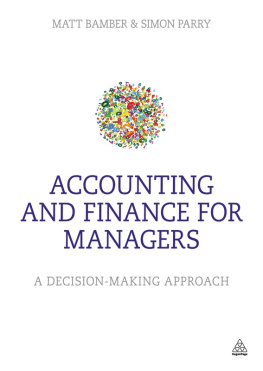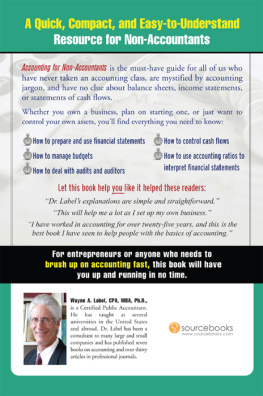
Copyright 2015 DVG STAR PUBLISHING
All rights reserved.
ISBN: 978-0992869410
ISBN-13: 0992869412
CONTENTS
ACKNOWLEDGMENTS
CHAPTER 1
GETTING STARTED
CHAPTER 2
MONEY MATTERS
CHAPTER 3CONTROL YOUR COST
CHAPTER 4
KNOW YOUR KPIs
CHAPTER 5
THE BASIC TAX FOR YOUR BUSINESS
CHAPTER 6
HOW TO ANALYSE PERFORMANCE
CHAPTER 7
BASIC HR & PAYROLL
CHAPTER 8
SAY YES TO ACCOUNTING SYSTEM
CHAPTER 9
BENEFITS OF VIRTUAL BOOKKEEPING IN THE DIGITAL AGE
CHAPTER 10
WHATS STOPPING YOU?
CHAPTER 11
WHO YOU KNOW?
CHAPTER 12
HOW TO USE LINKEDIN TO BUILD YOUR PROFESSIONAL BRAND
CHAPTER 13
CV WRITING TIPS
CHAPTER 14
INTERVIEW SUCCESS
CHAPTER 15
HOW TO ANSWER INTERVIEW QUESTIONS
CHAPTER 16
OPPORTUNITIES AND YOU
CHAPTER 17
INCREASE YOUR MIND POWER THROUGH SPIRITUAL ENERGY
CHAPTER 18
LEARN FROM THE HISTORIES OF WORLD LEADERS
CHAPTER 19
THE POWERFUL FORMULA FOR SUCCESS
CHAPTER 20
HOW TO OVERCOME PROCRASTINATION
CHAPTER 21
HOW TO TURN DEFEAT INTO VICTORY
CHAPTER 22
THINK BIG AND THINK POSITIVE
CHAPTER 23
MANAGE YOUR TIME
ACKNOWLEDGMENTS
I would like to express my deepest appreciation to my mentor Raymond Aaron, the New York Time Best Selling Author, who conveyed a spirit of adventure in regard to writing books. Without his guidance this book would not have been possible.
My sincere thanks go to the people who gave me assistance throughout this book; to all those who provided support, offered feedback, and assisted in the editing, proofreading and design.
I would like to thank DVG STAR Publishing for supporting me to publish this book.
This book would not have been possible without the support and encouragement of my lovely wife, Labosshy Mayooran.
Last but not least, I would like to thank my parents and teachers for guiding and mentoring me throughout my childhood to become an expert in my professional life, and the success of the book is dedicated to them.
CHAPTER 1
GETTING STARTED
What is accounting?
Accounting is the systematic process of recording, reporting and analysing the financial transactions of a business. In simple terms accounting helps a firm to identify whether the business is profitable or not.
The accountant who is responsible for maintaining the accounts of the company is expected to follow accounting principles and standards such as generally accepted accounting practices, also known as GAAP.
Which accounting is for you?
There are several types of accounting practiced in the corporate world, including financial accounting, management accounting, governmental accounting, tax accounting, forensic accounting, project accounting, and social accounting.
Financial accounting : The process of producing financial statements for external use. The financial statements will include the past and present performance of the business following certain accounting standards known as GAAP. There are many accounting systems available to prepare financial accounting, for example: sage line 50, QuickBooks and SAP.
Management accounting : Prepared for the internal use of the company. This takes place in the form of budgeting, cost accounting and so on. This is where management needs to be placed at higher priority as this will highlight the key performance indicators of the company, for example: sales, labour cost and food cost.
Accounting: how it works
The concept of accounting starts with the ideology of double entry. In simple terms, double entry means each and every transaction has a debit and credit effect. Given that the revenue is equal to the expenses of the company we can arrive at the fundamental formula of double entry.
Assets = Liabilities + Equity
For example if we take cash sales, the double entry for this will be as follows;
Cash debit
Sales credit
As the cash is coming in to the business it is debited and the sales are credited. We follow a standard practice for double entry which will communicate which entry should be debited and credited.
Debit | Credit |
Asset | Increase | Decrease |
Liability | Decrease | Increase |
Income | Decrease | Increase |
Expense | Increase | Decrease |
Shareholders Equity | Decrease | Increase |
The table above provides a clear picture about the basic double entry techniques used in accounting.
Now lets look at some of the basic definitions of accounting terms used in accounting practices:
Asset Any item of economic value owned by the company. For example: land, furniture, property, and so on. Assets can be mainly classified as long term assets, current assets (short term), and intangible assets (goodwill of the business).
Liability It is an obligation a company needs to pay. It can be in the form of debt or suppliers payments. Liabilities can be classified as current liabilities, which are the debt which needs to be settled within one year, and long term liabilities which are the debt which needs to be settled over a longer period (more than one year).
Income The total amount of money generated by the company for goods sold and services provided during a certain time period.
Expenses Any cost of running the business.
Shareholders equity An ownership stake in the company in the form of common stocks or preferred stock. It can also be calculated by deducting total liabilities from the total assets of the company.
Financial statement: what does it include?
Income statement Accounting of revenue, expenses, and net profit for a certain period. The period can be on a quarterly or yearly basis. The income statement is based on the fundamental equation,
Income = Revenue Expenses
Income statements will help you to identify whether the profits margin the business is generating is in line with industry standards.
Balance sheet Indicates the financial condition of a company at a specific time period. The first part of the balance sheet includes the assets a company owns and the second part includes the source of financing.
Cash flow statements Enable the management and investors to understand where cash is coming from and where the cash has been spent.
Which business structure is for you?
When you are structuring your business it is very important to select the correct business structure, as it is going to affect the amount of tax you are going to pay and the paper work you have to do.
The most common forms of businesses are:
- Sole proprietorship
- Partnership
- Corporation
- Limited Liability Company (LLC)
Sole Proprietorship
If you intend to work on your own, this structure will best suit your needs. Under sole proprietorship the owner is responsible for the debt. The business structure is very simple and easy to set up.
The external source of financing will be very difficult for sole proprietorship. In these instances the owner has to rely on his savings or investments.
Partnership
If you intend to operate with several business partners, then a partnership is the structure you must choose. A partnership can be classified by two types:

